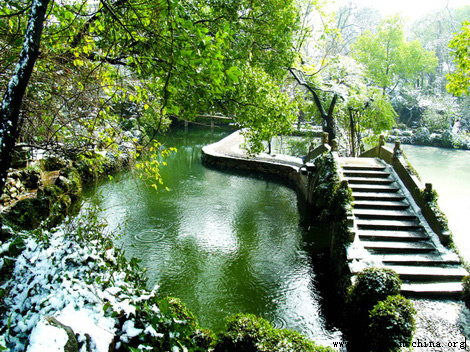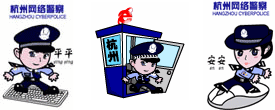| Home > Living In China |
Beijing's Hutong

The rickshaws
For most of the tourists from abroad or China who wish to visit Beijing, there are some spots they can't miss ; all of them deserve a visit and the future tourists already know all of them : the Great wall, the Forbidden City, the Summer Palace, the Temple of Heaven, and of course the famous hutong, a peculiar place in Beijing. Well, let's go there ! These hutong, whose name in Chinese characters 胡同 does not have in itself any precise meaning, is reportedly coming from the Mongolian word "hottog", meaning water well, of which Chinese language made a phonetic transcription. Supposed or real, even no sense at all, is not what matters here, but rather their Mongolian origin, because it is indeed from the period of the Mongolian Dynasty of Yuan, who ruled China from 1278 to 1368 that the origin of these famous lanes can be traced back, when Beijing was called then Dadu (大都, the Large Capital). The Hutong which can still be seen today date from this dynasty and the two following ones, the Ming (1368-1644) and the Qing (1644-1911). But unlike the 2010 visitor can imagine, there were once Hutong almost everywhere in the capital, often bearing names as picturesque as Mutton Meat Lane (羊肉胡同), Golden Fish Lane (金鱼胡同) or Beneficial Rain Lane (甘雨胡同) and Fried Noodles Lane (炒面胡同). Most of them have been destroyed, to the great displeasure of the Western tourists who can hardly imagine how hard were the living conditions in these districts. But the local inhabitants very often left without much regret these dwellings where the picturesque often competed with discomfort and dilapidation. Between history and modernity, the Beijingers have chosen. But don't be afraid, there is still enough of these Hutong, now well protected, to satisfy your eager for Pekinese authenticity.

The most famous hutong are those located in the Northern part of the city. I should say they deserve well their celebrity, because it is quite obvious that the landscape around is really splendid. Our visit will start in the district of Shichahai, in front of the Northern entry of the Beihai Park. You can't miss the place, because there is a lake there, a lake you can see from the street. Well, actually not only one lake, but rather three. Qianhai (前海), then the most famous of them, Houhai (后海), because you will find around it a whole string of bars, popular among the night birds from Beijing and abroad alike, and Xihai (西海).
This place was once the commercial port of Beijing, connected to the Great Canal, which ran from Hangzhou, in the South, towards Beijing. This vocation has long disappeared, and today these lakes are mostly a good place for the amateurs of canoeing in spring and summer, and of ice-skating during the winter, when the lakes are deeply frozen. It is very easy to lose one's way in this maze of lanes, and besides lose one's way does have its own charms. If you are not so courageous, you can still get a guide, or take a bicycle rickshaw, which swarm in the neighbourhoods of Houhai. Try them, at least once…
With a little chance, you may have the chance to visit one of the mythical places of the hutong, these famous quadrangle houses, the Siheyuan (四合院). Few of them are well preserved and have kept their original appearance now, mostly because of demographic pressure, and as a result you may be possibly feel disappointed in front of the incredible mess you will find in the courtyards of most of them. But if you can fall on a well preserved siheyuan (there is still some, don't be afraid), you will understand then that everything, or almost, is a symbol in itself there. So please come in…

But first, raise a little your head and look at the top of the door : but what are these strange hexagonal wood studs ? They are Menzan (门簪). Their number, or their absence, indicated the social status of the inhabitants of the place. Two, even none, for the common people, four for the more well-established people, like officials, for example. Their number could even go up to twelve, but in this case, the only place you could find so many Menzan is nothing less than the residence of Prince Gong, brother of the Xianfeng Emperor, and regent after the death of this one.

Here we are, there, in this square court. Buildings border it on its four sides, and perhaps may be there are some trees in the center. Nothing is left randomly there, and no one did live there randomly either : the northern building was reserved to the head of the family, the parents in general, but it could also be other people, if they had the highest rank in the family. In the eastern buildings, the sons. Why there ? Quite simply because, as everyone knows it, sons had a key role in the Chinese traditional culture ; and knowing that the sun rises to the east, the symbol will be easily understood. So the girls, of course, had their quarters quite naturally… in the western buildings. And how about the southern buildings then ? The south was the place left for the domestic staff, or, if there was no such staff, the building was often used as library.

As far as the trees are concerned, apart from the traditional persimmon trees, so typical of Beijing, you might also find three other kinds of symbolic plants : the pomegranates and the vine, as, for the first one contains many small seeds and the second many grains, they symbolized a lot of children. But you could also find a jujube tree, but in its case, the important meaning didn't lie in the fruits, but in the name of the tree itself, in Chinese zao (枣) homophonous of zao (早), which means early, referring to the traditional formula 早生贵子, used to wish (and that is still in use nowadays) the newlyweds to give soon birth to a child.
Well let's leave now this siheyuan and continue our walk. Going up Houhai from Shichahai, after having crossed a small marble bridge, we are now in one of the other important places of the district, the Yandan street (烟袋斜街), also universally known as Pipe Street. Strange name ? Not so sure… originally called Gulou Xiejie (鼓楼斜街 (Drum Tower oblique Street, because it ends in front of the Tower), it then took under the Qing Dynasty the name which it still has today. Two explanations exist : the first tells us that it is due to the fact that the Manchus, tobacco lovers, came there to buy the stuff they needed ; the other one, because of the shape of this street, which indeed has quite the shape of a Chinese pipe. Whatever it is, the name is undoubtedly related to tobacco. It should be noted that this street was also called in the years 1920's "Little Liulichang" (小琉璃厂) in reference to the famous antique dealers street of Beijing, just because after the fall of the Empire in 1911, many princes and nobles left penniless after having lost their titles and prebends, came here to sell their treasures to survive ; but if there is still today many things to buy in Pipe Street, these objects are far from being as precious as the treasures of these deposed princes…

But you will surely find there two of the oldest specialties of Beijing, the tanghulu (冰糖葫芦), skewers of caramelized small fruits (very similar to small apples), filled or not with paste of jujube or almond, a delightful specialty the Beijingers (and others…) love to eat in winter, and that since the oldest times. Cheap and delicious, try them ! Another specialty, unfortunately less and less frequent, surely because it requires a rare skill, the puffed up sugar figurines (糖人儿), which often represent the animals of the Chinese zodiac.

At the exit of this street, just in front of your eyes, you will see a massive tower-shaped monument, whose walls are covered with the same red coating as the Forbidden City. Here is precisely the Drum Tower, built during the Ming Dynasty. Behind it, a few steps away, the Bell Tower, also built during this dynasty.
What was the use of these buildings? Quite simply, they were used to regulate the life of the ancient Beijingers, at a time where watches and clocks still did not exist ; this kind of building existed in almost all the big cities of China, and thus are not specific to Beijing. But at least those two Beijing buildings are without any doubt among the oldest and the most beautiful of their kind.

The Drum Tower was used, among other things, to warn the inhabitants that it was time to go home, before the city doors get closed. It was every day between 19:00 and 21:00, two hours during which the drum was beaten (the days in old China were made of 12 periods of two hours, and not 24 hours as it is everywhere now).
As for the Tower of the Bell, well, its function was exactly the reverse, that is to say announce the inhabitants that they were allowed to get up and leave home, and the bell thus sounded between 3:00 and 5:00 in the morning.
This system lasted until the beginning of the 1920's of last century. The two buildings can be visited now, but if you have to choose, may be the Drum Tower will be your best choice, as it will offer the best view on the city, and more, you will have the opportunity to see a drum performance every hour.
However, be careful with the staircase… it is particularly stiff and if you feel somewhat giddy or aren't physically at your best, it will be quite hard. Hard to climb, and perhaps worse when you will have to go down…
It has 69 steps. There, this number is still a symbol. The architects built 69 steps just simply because in old China, a 70 year old man was considered to have already lived quite well and could pass away at any time. The figure of 69, lower than the fateful 70, was thus, to some extent, seen as a guarantee of solidity and longevity of the building. And the fact is that, in spite of the years, wars and restorations, after nearly 600 years, the tower is always there. Just like its neighbor, whose staircases do not have these famous 69 steps, and who collapsed in the 18th Century, before being rebuilt.
When you will be back on the ground again, if you still have a little energy, then go back to the lake, sit at a table to take a rest and have a drink. You undoubtedly deserved it well…
Custom
 more
moreWeb Dictionary
Primary&secondary
Beijing National Day School
Beijing Concord College of Sino-Canada
Brief Introduction of BCCSC Established in the year 1993, Huijia School is a K-12 boarding priva...Beijing Huijia Private School





 print
print  email
email  Favorite
Favorite  Transtlate
Transtlate 







